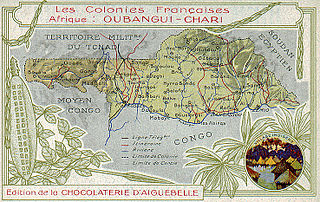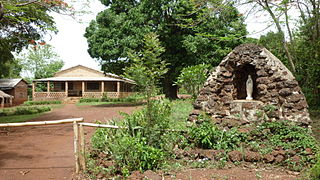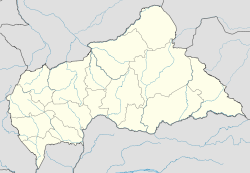
The Central African Republic is a landlocked country in Central Africa. It is bordered by Chad to the north, Sudan to the northeast, South Sudan to the southeast, the Democratic Republic of the Congo to the south, the Republic of the Congo to the southwest, and Cameroon to the west.

The history of the Central African Republic is roughly composed of four distinct periods. The earliest period of settlement began around 10,000 years ago when nomadic people first began to settle, farm and fish in the region. The next period began around 10,000 years prior.

Bangui is the capital and largest city of the Central African Republic. It was established as a French outpost in 1889 and named after its location on the northern bank of the Ubangi River ; the Ubangi itself was named from the Bobangi word for the "rapids" located beside the settlement, which marked the end of navigable water north from Brazzaville. The majority of the population of the Central African Republic lives in the western parts of the country, in Bangui and the surrounding area.

Central Africa is a subregion of the African continent comprising various countries according to different definitions. Middle Africa is an analogous term used by the United Nations in its geoscheme for Africa and consists of the following countries: Angola, Burundi, Cameroon, Central African Republic, Chad, Democratic Republic of the Congo, Republic of the Congo, Equatorial Guinea, Gabon, Rwanda, and São Tomé and Príncipe. These eleven countries are members of the Economic Community of Central African States (ECCAS). Six of those countries are also members of the Economic and Monetary Community of Central Africa (CEMAC) and share a common currency, the Central African CFA franc.

Obo is the capital of Haut-Mbomou, one of the 14 prefectures of the Central African Republic. It is close to the African Pole of Inaccessibility.

Bangassou is a city in the south eastern Central African Republic, lying on the north bank of the Mbomou River. It has a population of 24,447 and is the capital of the Mbomou prefecture. It is known for its wildlife, market, and nearby Bangassou Airport and is linked by ferry to the Democratic Republic of Congo on the south bank. The city is also home to the Roman Catholic Diocese of Bangassou.

Bouar is a market town in the western Central African Republic, lying on the main road from Bangui (437 km) to the frontier with Cameroon (210 km). The city is the capital of Nana-Mambéré prefecture, has a population of 40,353, while the whole sous-préfecture has a population of 96,595. Bouar lies on a plateau almost 1000m above sea level and is known as the site of Camp Leclerc, a French military base.
Baoro is a town located in the Central African Republic prefecture of Nana-Mambéré.

Boali is a town located in the Central African Republic prefecture of Ombella-M'Poko.
Nola is the capital of Sangha-Mbaéré, an economic prefecture of the Central African Republic. It is located at the confluence of the Kadéï and the Mambere river. The Sangha River is formed here due to the aforementioned rivers.

The Central African Republic Civil War is an ongoing civil war in the Central African Republic (CAR) involving the government, rebels from the Séléka coalition, and Anti-balaka militias.

The Anti-balaka is an alliance of militia groups based in the Central African Republic in the early 21st century said to be composed primarily of Christians. However, some church leaders have contested the claimed exclusively Christian character of such groups. The Tony Blair Faith Foundation and journalist Andrew Katz have noted that animists also participate in Anti-balaka groups.

Catherine Samba-Panza is a Central African lawyer and politician who served as interim President of the Central African Republic from 2014 to 2016. She was the first woman to hold the post of head of state in that country, as well as the eighth woman in Africa to do so. Prior to becoming head of state, she was Mayor of Bangui from 2013 to 2014. She is a non-partisan politician.

Joseph Kalite was a Central African politician and doctor. As a government minister he either held the housing or health portfolio. Kalite, a Muslim, was reported to be killed by anti-balaka outside the Central Mosque in the capital Bangui during the Central African Republic conflict. He was killed with machetes on the day in Bangui after interim president Catherine Samba-Panza took power. At the time of the attack Kalite held no government position, nor did he under the Séléka rule. He was reported to have supported the rule of Séléka leader Michel Djotodia.

United Nations Multidimensional Integrated Stabilization Mission in the Central African Republic is a UN peacekeeping mission, which started on April 10, 2014, to protect Central African Republic civilians under Chapter VII of the UN Charter. It transformed the 6,000-strong African Union-led peacekeeping force known as MISCA into a UN peacekeeping mission and became operational on September 15, 2014. The UN deployed a transition team to set up MINUSCA and prepare for a seamless transition of authority from MISCA to MINUSCA. As of 30 September 2021, it has more than 15,000 troops, police and civilian personnel on the ground. Its role is to:
Bambouti is a sub-prefecture of Haut-Mbomou in the Central African Republic.

Central African nationality law is regulated by the Constitution of the Central African Republic, as amended; the Central African Republic's Nationality Code, and its revisions; and various international agreements to which the country is a signatory. These laws determine who is, or is eligible to be, a national of the Central African Republic. The legal means to acquire nationality, formal legal membership in a nation, differ from the domestic relationship of rights and obligations between a national and the nation, known as citizenship. Central African nationality is typically obtained under the principle of jus sanguinis, i.e. by birth in the Central African Republic or abroad to parents with Central African nationality. It can be granted to persons with an affiliation to the country, or to a permanent resident who has lived in the country for a given period of time through naturalization.
Between 7 and 9 May 2017 at least 136 civilians were killed in series of reprisal killings by Anti-balaka and UPC fighters.
Sikkikede , also spelled Sikikédé, is a town in Vakaga Prefecture, Central African Republic. It is the largest settlement in Vakaga, with a population of around 20.000 people, and home to a rebel group, CPJP.
Dimitri Placide Ayoloma – is an Anti-balaka commander from the Central African Republic, active in Ouaka and Kémo prefectures. He is responsible for multiple crimes including killing of peacekeeper, looting, arson, assault and kidnapping for ransom.

















